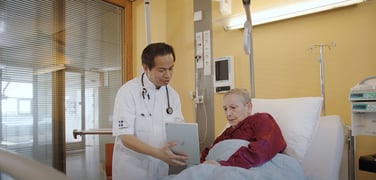What’s Next in Hospital Patient Engagement Solutions?
6 minute read | 06/08/2021

Hospital patient engagement solutions have already come so far, replacing outdated PHRs (Personal Health Records) with instantly accessible, interactive platforms that encompass entertainment as well as education. But how can patient engagement solutions be made even better?
In this blog, we discuss the evolution of patient engagement solutions as well as emerging patient needs—many of which are in part due to the pandemic—assessing how patient engagement solutions can further evolve to meet them.
- How Patient Engagement Solutions Have Evolved So Far
- How Patient Engagement Solutions are Changing Now
How Patient Engagement Solutions Have Evolved So Far
Siloed Systems
Previous patient engagement solutions consisted of little more than a telephone for basic phone communication, perhaps a TV above the bed or a radio as the only sources of entertainment.
To access health information, PHRs were available on request while education schemes were inconsistent across different hospitals and health facilities.
None of the above solutions were integrated, making them cumbersome to use. To switch from one entertainment outlet to another, a patient needed to use a different piece of technology, often requiring help from hospital staff or nurses to gain access.
Of course, this dampened a patient’s perception of hospital entertainment, not to mention decreased the adoption of educational materials across the entire hospital population, impacting readmission rates and patient engagement as a whole.
It was only in 2005 that hospitals started rolling out the more sophisticated solutions we see in hospitals today.
Moveable Screens
Connected to the bed frame via a moveable arm, updated screens provide more than just TV services and allow patients to use telephone services as well as adjust the position, find maximum comfort and help to alleviate and manage boredom.
Yet even though these screens were a step up from the previous IT—especially in terms of accessibility—these legacy systems had their own pitfalls, being slow to adapt to changing technology trends and in most cases, required a cost from the patient.
For reference, today’s on-demand streaming services cost, on average, £7.99 per month, giving customers access to thousands of TV programmes, with new blockbuster films and other content added every single week.
With such disparity between the at-home and hospital experience, there was obvious scope for solutions to progress yet again.
WiFi Web Browsing Solutions
The next step in patient engagement was the introduction of entertainment solutions, enabled via WiFi and available to any web browser user.
An example of this is our SPARK® Media package—an entertainment hub delivering free TV, radio, games and other entertainment services all in one, easy-to-use platform.
“When we developed SPARK® Media, we felt there was room for change in patient engagement both from a cost and quality perspective—and we were right. The platform was designed with the end-user in mind as it’s compatible with tablets, flat-screen TVs in private rooms and a variety of bedside units. To see all of these uses in action is always so rewarding, as well as hearing the positive feedback we’ve received from facilities claiming the platform has been completely transformational for their patient experience.” - Matt O’Donovan, CEO of SPARK TSL
The main benefits of this solution versus its predecessor are:
- Access to a variety of innovative digital services developed by the NHS driving digitally-enabled care
- The ability to provide free entertainment, education and support for all patients
- Significant cost savings for hospitals and reduced food wastage
- Enhanced entertainment and education options that patients are more likely to adopt and endorse
- An increase in patient engagement—empowering patients to independently interact with hospitals services, without the need for outside help or staff assistance
Clearly, this more modern approach to patient engagement provides a better solution for everyone, cutting costs for trusts and making hospital stays that bit more bearable for patients.
However, not every hospital has been so quick to embrace this update with many Trusts and facilities, sadly, being unable to prioritise digital transformation due to the onslaught of work created by the Covid-19 pandemic. This struggle to upgrade IT in healthcare isn’t reserved for patient engagement systems with an estimated 39% of IoT devices and 53% of common medical devices still operating on traditional, legacy platforms.
What’s more, these systems are set to change yet again to better meet new patient needs.
Although the infrastructure of the solution won’t need to change as it has done in the past, its features remain flexible to ensure patient engagement is as effective as it can be.
How Patient Engagement Solutions Are Changing Now
Forward-thinking patient engagement solution providers—SPARK TSL included—are hard at work updating their interface in line with new patient needs.
Although patient needs are bound to change over time, causing patient engagement platforms to reconsider their offering, user expectations have only been fast-tracked thanks to the pandemic and its after-effects. Now, patient engagement solutions need to change shape to fit the new healthcare landscape, keeping the ultimate goal of patient engagement in mind.
How Are Patient Needs Changing?
With more patients in hospital than ever before (a number that was creeping up even before coronavirus took hold), there are more patients to please, many of which are in compromising situations.
Many patients will find themselves isolated, unable to receive in-person visitation from friends and family, while others will be admitted into hospital after an unusually long wait. According to the BMA, 13X more patients are waiting over a year for specialist treatment in 2021.
As a result:
- Patients need to easily access other ways to communicate with the outside world, no matter their condition or capabilities
- Menial tasks like meal ordering must be streamlined to protect capacity and provide a more tailored nutritional service in line with a patient’s nutritional, dietary and cultural requirements and ultimately, their recovery plan
- Patient engagement platforms need to respond to the variety of digital services on offer across the NHS which aim to enable remote consultations and monitoring, as well as easy access to patient records for appropriate staff, to name a few
- Entertainment needs to be enhanced to provide much-needed comfort and distraction from the hospital environment, mimicking that of the at-home experience
- More stimulating entertainment options need to become available to all, especially to more vulnerable audiences such as those with dementia and children
- Patient engagement systems need to evolve to be as much about patient support as they are about entertainment, adopting features like live chat and interactive education
- Analytics and patient insights need to be readily available for facilities to review, giving them a closer look at how patient behaviour is rapidly changing and whether the new developments are proving effective
As a result, we’re focused on providing ways to better serve the patient and provider at a time when they both need it most, updating existing entertainment packages and communication systems, as well as adding entirely new features such as games and electronic meal ordering.
“Patient engagement solutions have never been more essential, especially for isolated patients. At SPARK TSL, we’re constantly thinking of ways to revolutionise the patient experience, both in terms of the quality of entertainment and the education that the patient receives. Now, we’re working with the NHS to combat some of the most critical healthcare challenges that the health system has ever faced to develop an updated patient engagement system that benefits both the platform’s user and its provider.” - Steve Killick, Product Manager at SPARK TSL
In this way, a next-generation WiFi-based patient engagement solution can help to diffuse patient tension, manage readmissions when hospitals are at capacity and protect patient happiness, even through the most challenging times.
About the author
Rebecca O'Donovan
Becky is the Marketing Director at SPARK TSL, of whom she has worked for since 2012. She is responsible for high-level marketing strategy focusing on lead generation and aiding the vision of the business to ensure business growth.
More articles by the author
Related articles
 Healthcare Industry
Healthcare Industry
Why Your Hospital Needs a Patient Engagement Platform | SPARK TSL
As we venture further into the digital era, patient engagement has become increasingly important for the ...
 Company News
Company News
Introducing SPARK Fusion, the Hospedia Upgrade
Understanding Hospedia, The Current Bedside Entertainment Solution If you’ve been to hospital, then you’ve ...
 Healthcare Industry
Healthcare Industry
What's Next in Hospital Patient Entertainment Systems? | SPARK TSL
When hospitals started to offer television in the early 2000s, the government saw it as a triumphant drive ...


